|
Tule
Ponds at Tyson
SHRUBS AND
VINES
NON NATIVE |
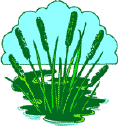 |
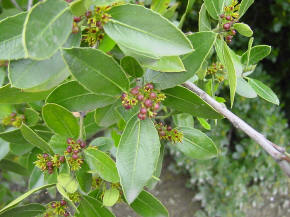 Italian Buckthorn
Family Rhamnaceae (buckthorn)
Rhamnus alaternus Italian Buckthorn
Family Rhamnaceae (buckthorn)
Rhamnus alaternus
This
evergreen shrub has an irregular upright form with a dense canopy.
Medium height about 5-7 meters with a spread of about 5 meters.
Leaves are dark green, serrated, glossy, and oval about 5 cm
in length. It is valued as a tough, low-maintenance street tree.
Appropriate beneath overhead wires. Disease and pest resistant and
attracts birds |
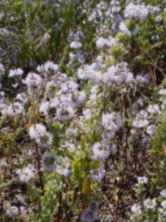 Blue Pennyroyal
Family Lamiacea (mint)
Mentha pulegium Blue Pennyroyal
Family Lamiacea (mint)
Mentha pulegium
This European native mint is
common throughout the Bay Area in low areas that are marshy all
winter, but dry in summer. It is a low-lying plant with small oval
or elliptical leaves. In late summer, its deep lavender purple
pom-pom like flowers gives color to the marsh. The leaves may be
used in stuffing or boiled to make tea. No parts of this plant
should be eaten by pregnant women because it is an abortive. |
|
 Apricot Apricot
Family Rosaceae (rose)
Prunus armeniaca
The old
apricot trees at the north end of the Lagoon are remnants of a
commercial orchard that once occupied this site. Apricots provide
food for wildlife, including raccoons, opossums, and house finches.
This tree is no longer living. |
|
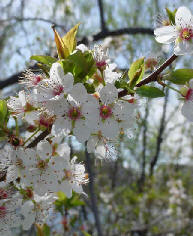 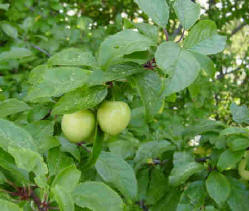 Yellow
and Red Myrobalan, Cherry
Plum Yellow
and Red Myrobalan, Cherry
Plum
Family Rosaceae (rose)
Prunus cerasifera
Myrobalan
plants are some of the largest and most vigorous of the plum or
prune woodstocks. Their wood is hard and long lived. Commercial fruit
trees would be grafted onto this tree because they are more
resistant than the preferred fruit. Cultivated cherry plums can have
fruits, foliage, and flowers in any of several colours. Some
varieties have sweet fruits that can be eaten fresh, while others
are sour and better for making jam. |
|
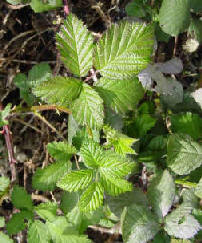 Himalayan
Blackberry Himalayan
Blackberry
Family Rosaceae (rose)
Rubus
armeniacus
This
non-native woody shrub is found in woodlands, marshes, riparian
areas, and parks. It is native to Armenia and Northern Iran. It looks similar to the California blackberry
except for leaf shape and thorns. The stems bear large, stout
spines. Its leaves are divided into 5 large leaflets that are
silvery on the underside. Rubus armeniacus occurs in
California in the coast ranges, Central Valley, and Sierra Nevada.
This weed is a strong competitor. It rapidly displaces native plant
species and thickets to produce such a dense canopy that the lack of
light limits the growth of other plants. This species is originally from Eurasia,
and is very aggressive in its spread, growing up to 10 feet per
year. The flowers are white to pinkish. This was
formally call Rubus discolor. |
|